Merrin Gallery In Italy's Antiquities Dragnet?
Merrin Gallery In Italy's Antiquities Dragnet?
By Suzan Mazur
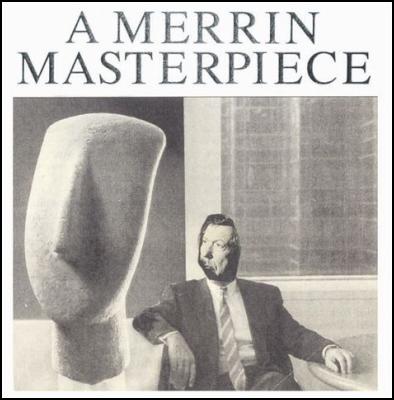
"This argument [H.R. 5643] is utter nonsense." --Ed Merrin
It is not totally surprising that New York antiquities dealer Ed Merrin appears to be caught in the dragnet of Italian prosecutors who are conducting a criminal trial in Rome, having already charged dealer Bob Hecht and former Getty Museum curator Marion True with conspiracy to traffic in ancient art. Merrin testified before US Congress in the 1970s in opposition to H.R. 5643, a bill designed to implement the UNESCO convention protecting cultural property. He has said "prohibition never worked and never will work".
He has also made the claim that there was only one other person dealing at his level of quality -- Robin Symes. And Symes has been on the Italians' dealer hit list since 1999 -- following the accidental death of Symes' partner Christo Michaelides, who fell down the stairs at the rented Italian villa of collectors Shelby White and Leon Levy [Michel van Rijn -- Symes Special].
Symes has been a supplier of ancient treasures to diamond & political influence peddler Maurice Tempelsman (beau of the late Jackie Kennedy Onassis) and fianancier Michael Steinhardt, for example.
The announcement last week that the Italians may seek a Merrin indictment -- alleging Merrin Galllery has been a "conduit" for antiquities smuggled out of Italy and sold to US museums -- sent me back into my Merrin files and an interview I did with Ed Merrin for The Economist magazine: "Museums and Galleries: Unholy Alliance?" in the Spring of 1990 to see where Merrin possibly first lost his footing.
Peter Watson in his new book, The Medici Conspiracy, cites Merrin Gallery writing a letter to European dealer Gianfranco Becchina, who Italian prosecutors have also initiated proceedings against as one of the antiquities smuggling kingpins. Watson reports Becchina was asked in the letter not to write his name on the back of photos of antiquities he sent to Merrin Gallery.
But it seems Ed Merrin first gained notoriety in the summer of 1989 when he outbid Robin Symes for a Cycladic marble head at Sotheby's. Symes was shopping for the Getty Museum at the time (although Merrin said he didn't know that). The idea that a dealer could outbid a museum caused a stir.
Merrin had a $10 million Wall Street investor at the time -- Asher Edelman, the man thought to have been the inspiration for Michael Douglas' character in the film Wall Street. Edelman's own art collection was valued at $100 million.
The Spedos Cycladic head Merrin bought became the most expensive piece of ancient art ever purchased at auction. Merrin paid $2.09 million for it. Many raised eyebrows saying Merrin was inflating market prices by paying so much.
According to Anthony Brandt writing for Connoisseur (January 1990), the same Cycladic head was purchased in the 1960s for $8,000 and Alan Safani later offered it to Cornelius Vermeule at the Boston Museum of Fine Arts for $125,000. Brandt said there were "no takers".
My interview with Ed Merrin took place at his Fifth Avenue gallery in April, just two months before the now-infamous Hunt-Sotheby's auction, where the Euphronios fragmentary vase and cup were on the block (the vase was bought by Robin Symes for the Levy-White collection, and now-convicted dealer Giacomo Medici bought the cup -- the same one he originally sold to Hecht, who then sold to Nelson Bunker Hunt -- making a complete circle). Again, Merrin bought heavily.

Click for big version
Among the "highly important" pieces Merrin racked up at Sotheby's were a Roman Bronze portrait head of a man ($577,500), an Etruscan Bronze Horse ($517,000), and a Roman Bronze portrait head of an old woman ($280,000) Merrin also bought an Attic Red-figure amphora fragment with part of the hand and instrument of a musician for $350,000, and other pieces.
I noted that Bob Hecht told me at the time the heads Merrin bought were each worth over $1 million.
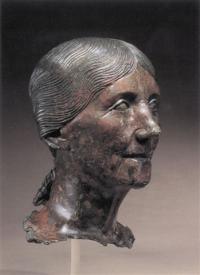
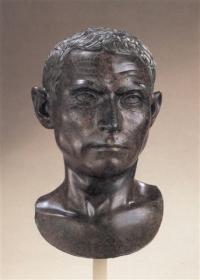
Click Images For Big Versions
Left: Roman Bronze head of a woman, Augustan or Julio-Claudian, 1st century BC/1st century AD. Photo: Sotheby's
Right: Roman Bronze portrait head of a man, Augustan or Julio-Claudian, late 1st century BC/early 1st century AD. Photo: Sotheby's
Merrin had also just held a controversial exhibition, "Masterpieces of Cycladic Art" (March 8-April 12, 1990), at his gallery to benefit the Brooklyn Museum, with pieces borrowed from the Metropolitan Museum of Art, the Brooklyn and the Barbier-Muller Museum in Geneva, as well as from collector/ financier Michael Steinhardt, real estate/pet foods mogul Leonard Stern and others.
Stern owned 10 Cycladic marbles and loaned all of them to Merrin for the show: Six Spedos pieces; a Dokathismata female (2400-2300 BC); the Anatolian "Stargazer" (3000-2500 BC) worth $1 millon and previously belonging to Nelson Rockefeller; a Sardinian female figure from the Ozieri culture (2000 BC); and a Cycladic female (2800-2700 BC) said to be from the same source as the Met's Cycladic "Harp Player". The Harp Player is a fake -- according to Met Ancient Near East expert Oscar White Muscarella.
The collection was housed at the time in Stern's Fifth Avenue townhouse aka Harmon Fine Arts Gallery, which did "sizeable transactions" in antiquities Stern told me in a phone call. Stern's secretary, warned me the address was not for publication and she said Stern used a second gallery when he needed additional space.
But the real star of the Merrin exhibition was the $2.09m Spedos head. And the show raised $70,000 on opening night. Tickets went for $250 with proceeds to benefit Brooklyn Museum's Department of Egyptian, Classical and Ancient Middle Eastern Art. A catalogue "Masterpieces of Cycladic Art" was also produced for sale with an introduction by Brooklyn Museum Director Robert Buck.
Curiously, one of the first pieces in the catalogue is a Cycladic marble male figure with two repair holes (3000-2800 BC) from Geneva's Barbier-Muller museum. Peter Watson in Medici Conspiracy says it's questionable whether male Cycladic figures were ever made in antiquity, and citing Oxford's thermoluminescence lab says "available tests don't work with stone" and fake Cycladic idols can be made "by wrapping in cooked spaghetti".
One room at the Merrin exhibit also had pieces for sale (an addendum to the catalogue gave prices -- Merrin's Dokathismata Cycladic figure was listed for $110,000, for example). So observers were unsure Brooklyn was, in fact, the main beneficiary. The feeling was that Brooklyn had allowed itself to be used. And curators at Brooklyn opposed to the arrangement had been powerless to stop it.
Various people weighed in on the controversy, including Brooklyn's Robert Buck, who, of course, approved of the museum-gallery collaboration, noting Merrin had also helped the museum to publish a catalogue on its Egyptian collection.
Buck later responded "No" to a question I faxed him: "Does the Brooklyn Museum recognize a distinction between fund raising events held at contemporary art galleries and those sponsored by antiquities dealers?"
Arielle Kozloff, then curator of ancient art at the Cleveland Museum and since 1997 working for Merrin, flew in for the Cycladic show. Kozloff is now also Secretary of the controversial American Council for Cultural Policy, a group headed by the Met's lawyer from the Euphronios purchase days, Ashton Hawkins. Some members of ACCP support a revamping of the Cultural Property Implementation Act making it easier to import foreign antiquities.
Kozloff said at the time of the Merrin Cycladic exhibit: "No one could have come away without being truly impressed by the mastery of Cycladic art. Merrin has fabulous taste and he pulled together great masterpieces."
She compared Merrin's hosting the benefit to a surgeon volunteering for the Red Cross or an attorney giving time to legal aid for the poor. "I come late to the appreciation of Cycladic Art," she said, "but he had works of art that I had never seen. I think he deserves a pat on the back. . . . I think it would be wonderful if more art dealers would become involved in fundraising."
Merrin, himself, told me he did it all "for love" because Brooklyn first gave him an introduction to classical art as a child and that he wouldn't be dealing if it weren't for the inspiration of Brooklyn.
But Merrin was already uncomfortable about media scrutiny from the Spedos purchase and during our interview expressed that he and Edelman were in the process of a 30-month "mutually agreed phase out".
Merrin also attempted to host a "Cocktail Reception and Talk" the following month in collaboration with the "Antiquities & Archaeology Committee of the American Friends of the Israel Museum". Invitations were sent out for the event which was to feature speakers Carlos Picon, the Met's "Curator in Charge" of the Department of Greek and Roman Art, and Cleveland's curator of Ancient Art, Arielle Kozloff.
But Picon complained his name had been used inappropriately in promoting the event and the event was cancelled.
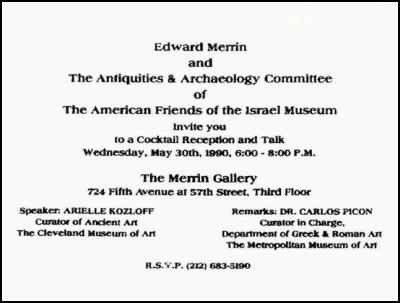
Invitation to the Merrin Cocktail Reception & Talk, later cancelled.
Picon did not return my call regarding the cancelled event. And Cleveland Director Evan Turner issued a statement through his press office saying he had "complete confidence in the complete integrity of his curators".
In a story involving antiquities dealer/smuggler Aydin Dikmen that I co-authored with Turkish journalist Ozgen Acar (slated for Connoisseur, which ceased publication before the story could run), we included a reference to the bonding of Kozloff and Merrin also over some animal figures Merrin exhibited in a show in 1982 entitled, "Anatolia: 3,000 B.C. Miniature Masterpieces."
Kozloff wrote a text published by Cleveland Museum in 1981 on the so-called Lake Van dickite stone animal figures -- Animals in Ancient Art from the Leo Mildenberg Collection, opening with a quote from Job about the Mildenberg "menagerie":
Ask now the beasts and they shall teach thee
and the fowls of the air, and they shall tell thee.
She said the figures were 4th millenium BC and made by ancestors of the Urartians, although Oscar Muscarella has remarked that the "Urartians lived in the 8th century BC" (north of Lake Van in present day Turkey).
Kozloff said they were an extraordinary group of objects probably deriving from a culture not yet known. Among the dickites featured in her book were: a guinea fowl with mushroom-shaped comb and forked tail, turtle with intaglio of a leaping stag, the head of a bear with the intaglio of a bent human, etc.
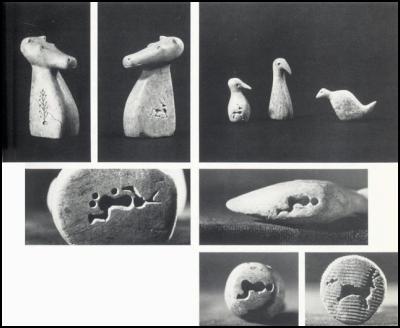
Click for big version
Cleveland curator Arielle Kozloff's book presentation of the dickite stone figures belonging to Swiss collector Leo Mildenberg.
Several people said the dickite figures closely resembled those Aydin Dikmen had in his collection and wondered if Dikmen had been the source.

Dikmen & Dickites Photo, Credit: Patricia Connor
Jonathan Rosen, a collector and fianancier/president of Bob Hecht's Atlantis Antiquities Ltd. gallery in New York, told me in June 1990 that he bought his animal pieces for $50 each from Fuat Uzulmez -- identified by Ozgen Acar and Melik Kaylan in a story for Connoisseur (October 1990), as the handsome "top lieutenant" in Munich's Turkish antiquities smuggling ring.
During my visit to Uzelmez's Munich art gallery in 1991 researching the Dikmen story, he told me he was about to take over as "chief" of the business since then-kingpin Edip Telli was retiring into real estate. Uzulmez said over coffee that "Dikmen makes the best fakes".
Uzelmez was also close to Rosen's partner, Bob Hecht. And Hecht in a lettter to Ozgen Acar about Dikmen agreed as to the "dangerous" quality of his fakes. He said the dickites were "produced locally in the Van region".
Ozgen Acar faxed a copy of the letter to me because Hecht mentioned me in relation to a story I wrote for The Economist about the Hunt-Sotheby's auction where I describe Hecht's arrest in Turkey over some ancient coins -- a point Peter Watson also makes in The Medici Conspiracy.
Hecht cornered me at an antiquities exhibition following publication of the magazine story and attempted to punch me in the face. [To view the Hecht letter click on this link to Scoop: Suzan Mazur: A Preview Of Bob Hecht's Memoirs]
Rosen told me he gifted 500 of the stone animal figures to the Boston Museum of Fine Arts, but said that Merrin "sold his dickites for $1,000 each calling them "miniature masterpieces". " Rosen also said that "experts almost unanimously agreed the pieces were fake".
"If the pieces [animal figures] are not fake," said former Archaeology Institute of America President James Wiseman, writing in the Journal of Field Archaeology in 1984, "then they are almost certainly looted from Eastern Turkey or Iran".
Rosen said he was always suspicious about the price and later had the stone analyzed, learning it was "serpentine with modern tool marks." He also said the market was flooded with the figures, noting West Coast dealer, Joel Malter had a collection, as well as Arakji, a dealer in London. Fayez Barakat bought 200 dickite pieces to offer his clients on Rodeo Drive; Barakat said he knew of at least 500 more of the pieces in Europe.
Dickites also turned up in the collection of the late Norbert Schimmel , and as mentioned, Swiss collector, Leo Mildenberg (Kozloff's book). Rosen said Mildenberg paid around what he paid for the animals.
Schimmel and Mildenberg asked Drs. Leonard Gorelick and John Gwinnett, the team of New York dentists who tested Rosen's collection, to test their pieces too, as did several other dealers. In all cases, after testing with x-ray diffraction and by silicon impression, the team concluded that drill holes in the figures were made by a flint drill but that "a contemporary forger could have made a flint drill and used it."
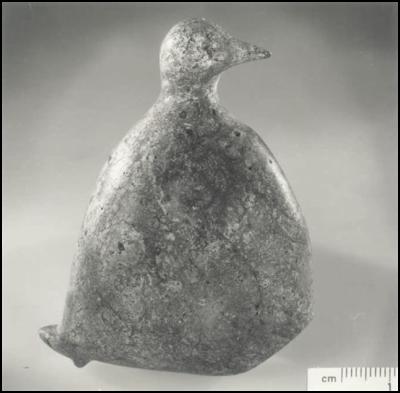
Dickite animal test. Photo: Dr. Leonard Gorelick
Rosen said Merrin did not participate in the tests. He also did not know who was advising Merrin about his purchases.
But, in an interview I did in 1990 with the late Bernard V. Bothmer, a former Curator of Ancient Art and Vice Director of the Brooklyn Museum (1960s-1982), who was then a teacher of Egyptian art at NYU's Institute of Fine Arts --Bothmer told me he remembered visiting Manhattan weekly during the Brooklyn days and stopping in at Merrin's and other galleries -- "especially when they call up and say, "we have something new we want to show you"."
"And I wanted to see it," said Bothmer, "I don't want my colleague from Berlin to say he was in New York and saw a statue that I never saw. I look down on that."
Bothmer, who was the well-liked brother of the Met's longtime Greek and Roman expert, Dietrich von Bothmer, added that dealers frequently used his name in letters saying, "Mr. Bothmer has seen it, he likes it," etc., and that Merrin probably did it too. In some cases, he said, "I didn't even know it [the piece] existed!"
Dr. Clemency Coggins noted a few years earlier as chair of the Department of Archaeology at Boston University and co-chair of the Archaeological Institute of America's Committee on Professional Responsibility:
"The size, the destructiveness and the money now involved in what used to be a relatively innocuous trade have turned scholar who would only authenticate a piece, into an accomplice. His opinion, however cautiously given, may determine the market value of a piece." (Boston Review, Aug. 1986)
It's actually surprising that the antiquities trade hasn't started imploding sooner, considering the vendetta that it is. For instance, Jonathan Rosen had this to say about Ed Merrin in June 1990:
Jonathan Rosen: I don't depend on Merrin for one crust of bread. . . . I finance Atlantis. And I'm a collector. And I know a little bit about this and that. My only dealings with Merrin have been peripheral.I was very irritated about his canceling my invitation to the Brooklyn [Cycladic art] show, otherwise I would have been kinder in my assessment of him, even though everything I said was nothing but the truth. . . . The general opinion of Ed Merrin amongst his peers is that he is rather ignorant and tasteless, which is true. . . .
Suzan Mazur: But I understand he did go to university.
Jonathan Rosen: Which university? The one of hard knocks?
Suzan Mazur: Clemency Coggins mentioned Tufts.
Jonathan Rosen: I would seriously doubt if Ed Merrin ever graduated from Tufts, although I'm sure he went to college. You have to understand his father was quite well-to-do. . . . He can't help if he lacks intellectual range.
Suzan Mazur: Regarding the Brooklyn Arts Council?
[Reference is to Brooklyn Museum's Egyptian, Classical and Ancient Middle Eastern Arts Council, some of whose members then included: Shelby White, Lawrence Fleischman, Canal Arts Corporation (Asher Edelman), Lily Auchincloss, Chase Manhattan Bank, N.A., Christie's and Drexel Burnham Lambert.]
Jonathan Rosen: It's all horse manure. You give money and they put your name down for something. You have meetings, lunch and someone gives a little talk. I'm advisor to the Art History department at Columbia University. I'm their expert on Near Eastern Art and Archaeology on the advisory council.There we actually have meetings. [Met Director] Philippe de Montebello and [Brooklyn Director] Robert Buck are also on the council.
Which begs the question -- just where does the thread or "corda" end? But the good news is that an Athens court has just unbanned the worship of Mt. Olympus gods Athena, Zeus, Hermes et al., perhaps inspiring a fresh supply of authentic pagan art.
 Suzan
Mazur's stories on art and antiquities have been published
in The Economist, Financial Times, Connoisseur, Archaeology
(cover) and Newsday. Some of her other reports have
appeared on PBS, CBS and MBC. She has been a guest on
McLaughlin, Charlie Rose and various Fox television news
programs. Email: sznmzr@aol.com
Suzan
Mazur's stories on art and antiquities have been published
in The Economist, Financial Times, Connoisseur, Archaeology
(cover) and Newsday. Some of her other reports have
appeared on PBS, CBS and MBC. She has been a guest on
McLaughlin, Charlie Rose and various Fox television news
programs. Email: sznmzr@aol.com


 Binoy Kampmark: Last Acts -Time For Biden To Pardon Assange
Binoy Kampmark: Last Acts -Time For Biden To Pardon Assange Binoy Kampmark: Foiling Rupert Murdoch - Project Harmony Misfires
Binoy Kampmark: Foiling Rupert Murdoch - Project Harmony Misfires Ian Powell: Commissioner’s Approach To Healthcare Provision - ‘Slash And Burn’
Ian Powell: Commissioner’s Approach To Healthcare Provision - ‘Slash And Burn’ Jack Yan: The Case For Brand Aotearoa
Jack Yan: The Case For Brand Aotearoa Ramzy Baroud: Unity Above Else - The Only Road to the Liberation of Palestine
Ramzy Baroud: Unity Above Else - The Only Road to the Liberation of Palestine Binoy Kampmark: Finding The Unmentionable - Amnesty International, Israel And Genocide
Binoy Kampmark: Finding The Unmentionable - Amnesty International, Israel And Genocide